Abstract
The accurate prediction of the amplitudes of vortex-induced vibrations (VIV) is important in wind-resistant design. Wind tunnel tests of scaled section models have been commonly used. However, the amplitude prediction processes were usually inaccurate because of insufficient evaluations of three-dimensional (3D) effects. This study presents experimental measurements of VIV responses in a prototype rectangular prism and its 1:1 two-dimensional section model in smooth flow. The results show that the section model vibrates with the same Reynolds number, equivalent mass, frequency, and damping ratio as those of the prototype prism without scale effects. The VIV amplitudes can be qualitatively and quantitatively measured and analyzed. The measured VIV lock-ins of these two models agree with each other. However, the prototype prism produces a 20% higher maximum amplitude than the section model. Several classical VIV mathematical models are used to validate the wind tunnel test results. This confirms that the 3D coupling effects of the modal shape and the imperfect correlations of excitation forces positively contribute to the maximum amplitude. Based on the section model outcomes, the amplified factor of 1.2 is found to be appropriate for the amplitude prediction of VIV for the present prism, and it can also provide a reference for other structures.
1. Introduction
Resonance vibration of a structure occurs when frequencies of regularly shedding wake vortices coincide with one of its natural frequencies. Moreover, the resonance vibration locks the vortex shedding frequency to the vibrating frequency and persists in the wind speed range beyond the initial velocity, thus achieving vortex-induced vibration lock-in. The vortex-induced vibrations (VIV) may occur at relatively low wind velocities and would affect the safety and the comfortability of the structure. This is a serious problem for flexible structural components and for other offshore structures exposed to flowing fluids that have been investigated extensively [1,2,3].
The evaluation of VIV responses, especially the maximum amplitude prediction, is one of the most important aspects of the wind-resistant design of flexible structures. Various empirical methods have been proposed and investigated for the prediction of the maximum amplitude owing to VIV [4,5]. Structural mass, damping, Strouhal number, and aerodynamic force coefficients are essential two-dimensional (2D) parameters and are used to predict the VIV amplitudes. Moreover, three-dimensional parameters (3D), such as the mode shape and spanwise correlation, are indispensable for maximum amplitude prediction of flexible structures [6,7,8].
Given that the effects of the complexities of the nonlinear fluid–structure interaction have been identified, wind tunnel tests are still the primary test type used for the evaluation of the susceptibilities of flexible structures owing to vortex-induced vibrations. Generally, a rigid section model with finite length is mounted elastically in the cross-flow to consider the 2D effects on vibration amplitudes [9], while the evaluation of 3D effects on the VIV amplitudes has stimulated researcher interest. This is attributed to the fact that the effects of the modal shapes and the spanwise correlations have not been considered in the wind tunnel tests of section models [10,11,12,13,14]. Fujino and Yoshida [15] illustrated that the VIV amplitude of the full-scale model of the Tokyo Bay Bridge was approximately 50% larger than that of its corresponding section model. Macdonald et al. [16] showed that the measured amplitudes of VIV on the Second Severn Bridge were larger than the results from the section model tests and concluded that the modal shape correction factor can likely explain the differences. Li et al. [17] investigated the VIV amplitudes of the full-scale model of the Xihoumen suspension bridge, and these amplitudes were significantly larger than the results of the section model tests. Zhou et al. [18] employed both a wind tunnel test of the large-scale sectional model and computational fluid dynamics to investigate the aerodynamic appendices and the mechanism responsible for VIV suppression. Larsen et al. [19] and Frandsen et al. [20] demonstrated that the maximum amplitudes of VIV from field measurements were larger than the wind tunnel test results measured at two damping levels in the case of the Great Belt Suspension Bridge. Moreover, measurements of some flexible aeroelastic models and their section models in well-controlled wind tunnel flow conditions showed the same trend [21,22].
For the evaluation of three-dimensional effects on VIV maximum amplitude, most of the previous works used field measurements and scaled model wind tunnel tests results. However, field measurements cannot provide controllable flow conditions, while scaled model wind tunnel tests are affected by the Reynolds number, with the comparison accompanied by several uncontrollable parameters. This study aims to perform research based on the elimination of these disturbances. A 3D long prism with a length of 4.5 m and a cross-section of 50 mm × 70 mm in fixed-fixed boundary conditions and its 1:1 2D section model with the same cross-sectional size are tested in the same wind tunnel. The wind tunnel tests of these two models are conducted with the same flow conditions, vibration frequency, mass, and damping ratio to avoid the effects of Reynolds and other scaling effects. The measured results are summarized in terms of the onset of wind velocities, lock-in range, and maximum amplitudes of vortex-induced vibrations. These measurements are also compared with the results of mathematical models. The amplitudes of VIV are qualitatively and quantitatively analyzed from the 3D perspective.
2. Theoretical Background
The mathematical model for VIV is briefly presented in this section. The equation of motion for a flexible prism with a length L undergoing vortex-induced vibrations may be expressed as:
where Yr represents the modal displacement; Mr, ωr, and ζr represent the effective mass, the natural circular frequency, and the damping ratio of the rth mode of vibration, respectively; and P(t) is the per unit length owing to vortex shedding.
According to the single harmonic oscillator vortex-induced vibration mathematical model [1], the vortex shedding lift force approximates a simple harmonic excitation expressed as:
where ρ is the air density, U is the incoming wind speed, D is the cross-wind dimension of a cross-section, is the fluctuating lift coefficient of vortex shedding, and ω is the vortex shedding frequency, which is close to the natural frequency when a lock-in phenomenon occurs.
Substitution of Equation (2) into Equation (1) yields:
When the prism resonates under the excitation of vortex shedding, the vortex shedding frequency ω is very close to the prism’s natural circular frequency ωr. The solution for the amplitude of modal displacement Yr can be expressed as:
where the factor R allows the imperfect correlation of vortex shedding to force along the length of the prism. It can be referenced as bridge deck [23]. Several studies have been conducted with a focus on the spanwise correlation effects of vortex-induced forces in separate smooth and turbulent flow conditions [24,25,26]; the main consensus can be drawn as the greater the vibration amplitude, the more the correlation length, while the quantitative results are varying between amplitude, cross section, Reynolds number, etc.
The non-dimensional vibration amplitude can be rewritten as:
where m is the equivalent mass of per unit of length of the prism, SC is the mass-damping parameter (Sc number), SC = 4πmζr/ρD2, St is the Strouhal number of the prism’s cross-section, and St = frD/U, while the last term on right hand side of Equation (5) represents the modal shape correction factor for the vibration amplitude. Equation (5) is one of the formulae used in Euro Code to estimate the VIV’s maximum amplitude [4,27].
It can be observed from Equation (5) that both the structural and aerodynamic parameters include the Scruton and Strouhal numbers, fluctuating lift coefficient, spanwise correlation, and modal shape correction that affect the maximum VIV amplitude. As mentioned before, it is common to use the section model wind tunnel test to predict the maximum VIV amplitudes for actual structures. However, the longitudinal deformed modal shape and imperfect spanwise correlation of vortex shedding forces are not considered in the sectional model test. This may lead to unreliable results. In the present study, comparisons were conducted between the wind tunnel test of a 3D rectangular prism prototype and a 1:1 2D section model. The discrepancies in cross-sectional dimensions, Reynolds number, Strouhal number, Scruton number, and natural frequencies were eliminated. Therefore, the differences in the maximum VIV amplitudes between these two models will only be caused by the 3D effects, namely, the modal shape and the spanwise correlation of vortex shedding forces. Accordingly, the correction factor for the maximum VIV amplitudes between the section model and the prototype prism were then evaluated.
3. Experimental Setup
All the tests were performed in a closed-circuit wind tunnel at Hunan University, China. One of the test sections in which the 3D prototype prism tests were performed had a width of 5.5 m, a height of 4.5 m, and a maximum wind velocity up to 16 m/s. The other test section had smaller cross-sections with a width of 3.0 m, a height of 2.5 m, and a higher wind velocity up to 58 m/s. The 2D section model tests were conducted in the smaller test section. All the tests were designed to perform smooth flow conditions.
The 3D prototype rectangular prism was made of a rectangular steel tube with the dimensions of 50 × 70 × 4500 mm. As shown in Figure 1, the prism was well fixed between the top and bottom parts of the wind tunnel. The flow condition distortion caused by the boundary condition was alleviated considerably with the use of a plane end-plate. Four accelerometers were employed to record the along-wind and cross-wind responses at the mid-span and quarter-span of the prototype prism, as illustrated in Figure 2, and the sampling frequencies were 200 Hz.

Figure 1.
Wind tunnel test setup of the prototype prism.
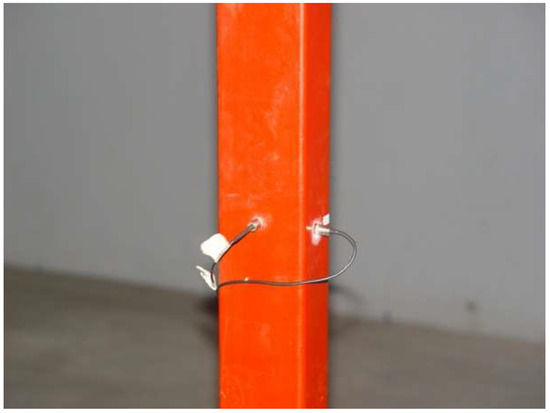
Figure 2.
Accelerometers installed on the prototype prism at mid-span.
The experimental setup of the 1:1 2D section model, which was made of organic glass (a type of polymethylmethacrylate) material, is shown in Figure 3. The 2D rigid section model adapts eight springs and two circular endplates (diameter = 210 mm) at both ends to guarantee the 2D flow conditions around the model. The section model system has six possible degrees of freedom (DOFs), as shown in Figure 4. There are three translational DOFs and three rotational DOFs, along with X-X, Y-Y, and Z-Z axes, respectively. The translational DOFs in the directions of the X-X and Z-Z axes were restricted in the section modal system, as was the rotational DOF in the direction of the Y-Y axis. The other three available DOFs of the section model system were the translational DOFs in the directions of the Y-Y axis (heaving mode) and Z-Z axis (rolling mode), respectively, as well as the rotational DOF in the direction of the X-X axis (pitching mode).
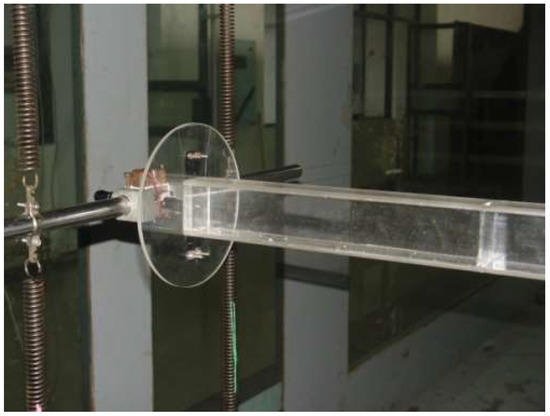
Figure 3.
Section model setup.
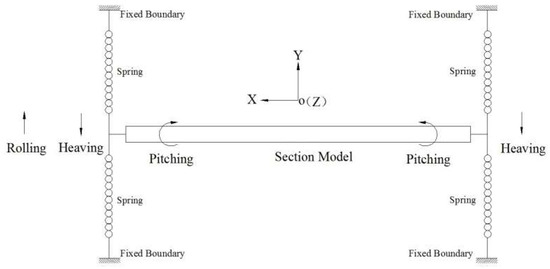
Figure 4.
Possible degrees of freedom (DOFs) of the section model.
Both the 3D prototype prism and the 2D section model were perpendicular to each other and faced the oncoming wind flow with the long edge of the cross-section (70 mm side) during wind tunnel tests. Two model tests were performed in separate wind tunnel sections. It is possible to vary the flow conditions even in the controlled smooth flow conditions. The onset wind velocity of the vortex-induced vibration was >8 m/s. This was measured such that the wind profile was very close to the turbulence intensities.
The comparison of the main parameters of the 3D prototype prism with the 1:1 2D section model is shown in Table 1. The surface roughness of the prototype prism and section model was different. The steel prototype prism was painted as smoothly as possible to make it similar to the organic glass material section model. Both the 3D prototype prism and the 2D section model had the same cross-sectional dimensions and almost the same mass, damping, and natural frequencies. The Reynolds number corresponded to the peak of the VIV lock-in.

Table 1.
Main model parameters.
4. Results and Discussion
4.1. Measurement Results
During the wind tunnel tests, the measured vibration time histories exhibited unsteady behaviors in both the 3D prototype prism and 2D section model due to high dominant vibration frequencies and damping ratios. The determination of vibration amplitudes at a certain oncoming wind-velocity point was evaluated by amplifying the root mean square (RMS) of the fixed 55 s time history of responses by a factor of . The 55 s duration was proven to be long enough to ensure the result was reliable and repeatable based on the collected 180 s time history.
Figure 5 and Figure 6 exhibit the time series of crosswind responses and the corresponding power spectral density (PSD) at the middle and quarter points of the 3D prototype prism, respectively. It can be observed in Figure 6 that the crosswind oscillations of the 3D prototype prism are dominated by the fundamental mode at 12.89 Hz without contributions from higher modes. The experimentally measured curves of dimensionless amplitude responses (A/D) versus normalized wind velocity (U/f0D) and dominating frequency curves are illustrated in Figure 7. VIV lock-in is clearly observed, and the wind velocity for the peak of lock-in is 8.3 m/s. Experimentally, the measured dimensionless amplitude (A/D) responses at the middle and quarter spans of the prototype prism were respectively obtained and were equal to 0.036 and 0.026, with a ratio of 1.38.
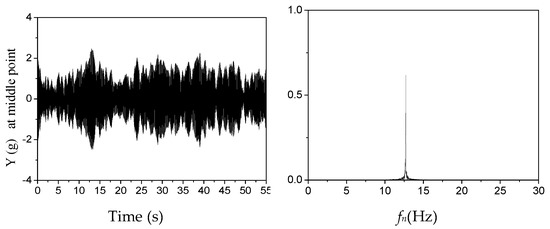
Figure 5.
Crosswind oscillation details (U = 8.3m/s, U/f0D = 7.9) at the middle point of the three-dimensional (3D) prototype prism.
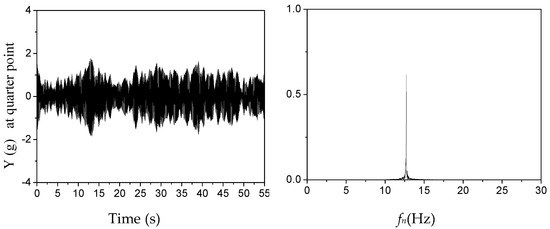
Figure 6.
Crosswind oscillation details (U = 8.3m/s, U/f0D = 7.9) at the quarter point of the 3D prototype prism.
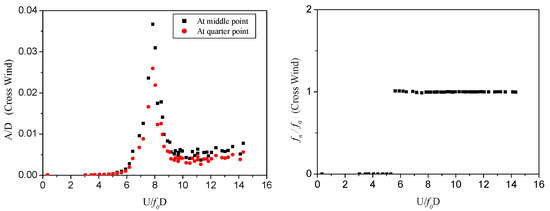
Figure 7.
Crosswind amplitude and frequency response of the 3D prototype prism.
The VIV responses of the 1:1 2D section model are demonstrated in Figure 8 and Figure 9. Nonconstant and unsteady amplitude is observed in the time-domain. However, the resonant single-frequency PSD curves can be obtained and are shown to coincide with the results of the 3D prototype prism tests. Figure 9 presents the heaving mode amplitude-velocity response and its corresponding frequency-velocity response. A single VIV frequency (a dominant peak in PSD close to the heaving mode natural frequency) lock-in is observed. No significant response is observed for the rolling and pitching modes.
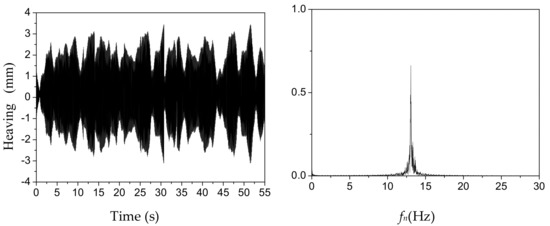
Figure 8.
Heaving mode oscillation details (U = 7.8 m/s, U/f0D = 7.4) of the two-dimensional (2D) section model.

Figure 9.
Heaving mode amplitude and frequency response of the 2D section model.
4.2. Empirical Estimation
VIV amplitude estimations of the 3D prototype prism and the 2D section model were conducted for comparison with the measured experimental results according to the empirical formula proposed in the Euro Code [27]. The estimation method focuses on slender structures with a typical cross-section (rectangular cross-section is one of them) and is established on a large amount of experimental and field test data. The formula used to estimate the VIV amplitude is:
where St is the Strouhal number, the empirical values for a rectangular cross-section can be found in Euro Code, Sc is the Scruton number, K is the mode shape correction factor, Kw is the spanwise correlation length factor, Clat is the lateral force coefficient, and the boundary condition of the present 3D prototype prism is fixed. The estimated result and the values of the relevant parameters are listed in Table 2. It can be observed that the estimated result of the 3D prototype prism fits well with the experimentally measured results.

Table 2.
Comparison of vortex-induced vibrations (VIV) amplitude between predicted and experimental results.
4.3. Comparison
According to the Euro Code, the estimated VIV amplitude of the 3D prototype prism (equal to 0.037) is very close to the 3D prototype prism test result (equal to 0.036), even though the measured wind tunnel time histories are not steady. Modifications of the 3D effects, which are different from our traditionally 2D plane and 3D solid body differences [28,29], mainly including the effects of modal shape, spanwise correlation, and aerodynamic forces, are indispensable effects that can be considered in the evaluation of the maximum amplitude of the VIV for prototype structures, as observed in the Euro Code’s empirical formula. However, the 3D effects interact and couple with each other during the actual oscillations. Their contributions to the maximum amplitude are not easily extracted. The coupled effects may be varied by choosing different structural cross-sections, boundary conditions, and vibration amplitudes.
The present study eliminates the geometric scale effects by adopting the same cross-section, Reynolds number, structural mass, and damping. The comparison of the maximum VIV amplitudes between the 3D prototype prism and the 1:1 2D section model is shown in Figure 10. The 3D effects can be directly identified. The expected agreements of the VIV lock-in between them are observed. These include onset velocities, initial branches, and lower branches. However, the maximum VIV amplitude of the 3D prototype prism (at the middle point of the prism) attains a value of 0.036. It is slightly higher than 0.030, which was obtained by the 1:1 2D section model at the ratio of 1.2. This observation may explain the fact that the full-scale VIV amplitudes measured in actual structures are often larger than those from section model tests.
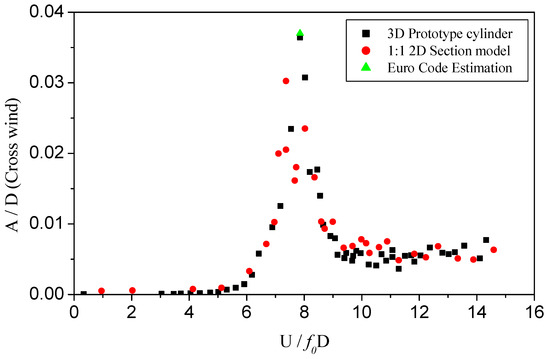
Figure 10.
The comparison of the maximum amplitude response between the 3D prototype prism and the 2D section model.
5. Conclusions
Without any scaling effects, given the same cross-section, mass, damping, vibrating frequency, Reynolds number, and flow conditions, the comparative three-dimensional (3D) prototype rectangular prism and the 1:1 2D section model wind tunnel tests were performed. The 3D effects, including mode shape and spanwise correlation, were the only difference between these two models to be comparatively examined.
Three-dimensional mode shape can contribute positively to the maximum amplitude for the prototype prism, while spanwise correlation works to the contrary. Sometimes the two parameters even interact according to amplitude responses and cross section, for which there is no concise conclusion. The present study shows that the 3D effects owing to the mode shape and the imperfect correlation of the excitation forces generally contribute to the maximum amplitude positively in the present 50 mm × 70 mm rectangular prism.
The prototype prism achieved higher maximum vortex-induced vibration amplitudes than the section model by a factor of 1.2, which can be used as a reference for similar structures in VIV amplitude prediction, while the direct use of the factor could be limited due to the various affected parameters of VIV, e.g., cross section, Reynolds number, and boundary condition.
Author Contributions
All the authors made significant contributions to the work. S.Z., Y.Z. and X.H. conceived this study; S.Z., Z.L. and Y.Z. completed the tests and analyzed the data; S.Z. and X.H. provided advice for the preparation and revision of the paper; Y.Z. and S.Z. wrote the paper; and S.Z. and X.H. reviewed the manuscript for scientific content. All authors have read and agreed to the published version of the manuscript.
Funding
The authors gratefully acknowledge the support of the National Natural Science Foundations of China (Project Nos. 52078504, 51508580, 51708202 and 51422806), the Scientific Research Plan of Hunan Province of China (Project Nos. 2019RS2051,2018JJ3577), and the National Key R&D Program of China (Project No. 2017YFB1201204).
Conflicts of Interest
The authors declare that there is no conflict of interest regarding the publication of this paper.
References
- Simiu, E.; Scanlan, R.H. Wind Effects on Structures—An Introduction to Wind Engineering; Wiley-Interscience: Hoboken, NJ, USA, 1953. [Google Scholar]
- Niu, H.; Zhou, S.; Chen, Z.; Hua, X. An empirical model for amplitude prediction on VIV-galloping instability of rectangular cylinders. Wind. Struct. Int. J. 2015, 21, 85–103. [Google Scholar] [CrossRef]
- Ding, J.; Chen, X.; Zuo, D.; Hua, J. Fatigue Life Assessment of Traffic-Signal Support Structures from an Analytical Approach and Long-Term Vibration Monitoring Data. J. Struct. Eng. 2016, 142, 04016017. [Google Scholar] [CrossRef]
- Ruscheweyh, H.; Langer, W.; Verwiebe, C. Long-term full-scale measurements of wind induced vibrations of steel stacks. J. Wind. Eng. Ind. Aerodyn. 1998, 74–76, 777–783. [Google Scholar] [CrossRef]
- Shimada, K.; Ishihara, T. Predictability of unsteady two-dimensional k−ε model on the aerodynamic instabilities of some rectangular prisms. J. Fluids Struct. 2012, 28, 20–39. [Google Scholar] [CrossRef]
- Zhang, Z.T.; Ge, Y.; Chen, Z. Vortex-induced oscillations of bridges: Theoretical linkages between sectional model tests and full bridge responses. Wind. Struct. Int. J. 2014, 19, 233–247. [Google Scholar] [CrossRef]
- Govardhan, R.N.; Williamson, C.H.K. Defining the ‘modified Griffin plot’ in vortex-induced vibration: Revealing the effect of Reynolds number using controlled damping. J. Fluid Mech. 2006, 561, 147–180. [Google Scholar] [CrossRef]
- Chen, Z.-S.; Tse, K.T.; Kwok, K.C.S.; Kareem, A. Aerodynamic damping of inclined slender prisms. J. Wind. Eng. Ind. Aerodyn. 2018, 177, 79–91. [Google Scholar] [CrossRef]
- Huang, S.; Li, R.; Li, Q.-S. Numerical simulation on fluid-structure interaction of wind around super-tall building at high reynolds number conditions. Struct. Eng. Mech. 2013, 46, 197–212. [Google Scholar] [CrossRef]
- Riedman, M.; Sinh, H.N.; Letchford, C.; O’Rourke, M. Full-scale investigation of wind-induced vibrations of a mast-arm traffic signal structure. Wind. Struct. Int. J. 2015, 20, 405–422. [Google Scholar] [CrossRef]
- Chen, Z.; Tse, K. Identification of physical nonlinearities of a hybrid aeroelastic–pressure balance. Nonlinear Dyn. 2019, 98, 95–111. [Google Scholar] [CrossRef]
- Chen, Z.Q.; Liu, M.G.; Hua, X.G.; Mou, T.M. Flutter, Galloping, and Vortex-Induced Vibrations of H-Section Hangers. J. Bridg. Eng. 2012, 17, 500–508. [Google Scholar] [CrossRef]
- Lee, S.J.; Kim, J.J.; Yeom, E. Vortex-induced reconfiguration of a tandem arrangement of flexible cylinders. Wind. Struct. Int. J. 2015, 21, 25–40. [Google Scholar] [CrossRef]
- Ji, C.; Peng, Z.; Alam, M.M.; Chen, W.; Xu, D. Vortex-induced vibration of a long flexible cylinder in uniform cross-flow. Wind Struct. Int. J. 2018, 26, 267–277. [Google Scholar] [CrossRef]
- Fujino, Y.; Yoshida, Y. Wind-Induced Vibration and Control of Trans-Tokyo Bay Crossing Bridge. J. Struct. Eng. 2002, 128, 1012–1025. [Google Scholar] [CrossRef]
- Macdonald, J.; Irwin, P.A.; Fletcher, M. Vortex-induced vibrations of the Second Severn Cross cable-stayed bridge-full-scale and wind tunnel measurements. Proc. ICE Struct. Build. 2002, 152, 123–134. [Google Scholar] [CrossRef]
- Li, H.; Laima, S.; Zhang, Q.; Li, N.; Liu, Z. Field monitoring and validation of vortex-induced vibrations of a long-span suspension bridge. J. Wind. Eng. Ind. Aerodyn. 2014, 124, 54–67. [Google Scholar] [CrossRef]
- Zhou, Z.; Yang, T.; Ding, Q.; Ge, Y. Mechanism on suppression in vortex-induced vibration of bridge deck with long projecting slab with countermeasures. Wind. Struct. Int. J. 2015, 20, 643–660. [Google Scholar] [CrossRef]
- Larsen, A.; Esdahl, S.; Andersen, J.E.; Vejrum, T. Storebælt suspension bridge—Vortex shedding excitation and mitigation by guide vanes. J. Wind Eng. Ind. Aerodyn. 2000, 88, 283–296. [Google Scholar] [CrossRef]
- Frandsen, J. Simultaneous pressures and accelerations measured full-scale on the Great Belt East suspension bridge. J. Wind. Eng. Ind. Aerodyn. 2001, 89, 95–129. [Google Scholar] [CrossRef]
- Mannini, C.; Belloli, M.; Marra, A.M.; Bayati, I.; Giappino, S.; Robustelli, F.; Bartoli, G. Aeroelastic stability of two long-span arch structures: A collaborative experience in two wind tunnel facilities. Eng. Struct. 2016, 119, 252–263. [Google Scholar] [CrossRef]
- Zhou, S.; Hua, X.; Chen, Z.; Chen, W. Experimental investigation of correction factor for VIV amplitude of flexible bridges from an aeroelastic model and its 1:1 section model. Eng. Struct. 2017, 141, 263–271. [Google Scholar] [CrossRef]
- Caracoglia, L.; Noè, S.; Sepe, V. Nonlinear Computer Model for the Simulation of Lock-in Vibration on Long-Span Bridges. Comput. Civ. Infrastruct. Eng. 2009, 24, 130–144. [Google Scholar] [CrossRef]
- Li, M.; Li, M.; Yang, Y. Strategy for the determination of unsteady aerodynamic forces on elongated bodies in grid-generated turbulent flow. Exp. Therm. Fluid Sci. 2020, 110, 109939. [Google Scholar] [CrossRef]
- Sun, Y.; Li, M.; Li, M.; Liao, H. Spanwise correlation of vortex-induced forces on typical bluff bodies. J. Wind. Eng. Ind. Aerodyn. 2019, 189, 186–197. [Google Scholar] [CrossRef]
- Wilkinson, R.H. Fluctuating pressures on an oscillating square prism. Part II. Spanwise correlation and loading. Aeronaut. Q. 1981, 32, 111–125. [Google Scholar] [CrossRef]
- European Committee for Standardization. The European Standard EN code-Basic of Structural Design; CEN: London, UK, 2004. [Google Scholar]
- Steiros, K.; Hultmark, M. Drag on flat plates of arbitrary porosity. J. Fluid Mech. 2018, 853, R3. [Google Scholar] [CrossRef]
- Steiros, K.; Kokmanian, K.; Bempedelis, N.; Hultmark, M. The effect of porosity on the drag of cylinders. J. Fluid Mech. 2020, 901, R2. [Google Scholar] [CrossRef]
Publisher’s Note: MDPI stays neutral with regard to jurisdictional claims in published maps and institutional affiliations. |
© 2020 by the authors. Licensee MDPI, Basel, Switzerland. This article is an open access article distributed under the terms and conditions of the Creative Commons Attribution (CC BY) license (http://creativecommons.org/licenses/by/4.0/).